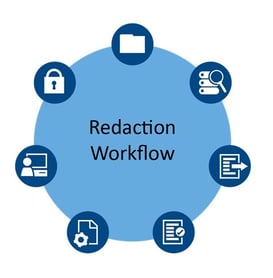By now you may have heard of “automated redaction software” but what is it exactly and what can it do for your organization? Automated redaction software is used to automatically locate and redact sensitive data fields (also known as “restricted identifiers”) in electronic documents received for filing in public record systems. It can integrate with most modern case and records management systems. It can be used with electronic documents as they are received for filing or on previously scanned or eFiled electronic images stored in a database.
Let’s take a look at some of the major benefits this powerful tool can provide:
1. Enhance business strategy while increasing efficiency
Most courts have rules and policy in place to prevent “restricted identifiers” from being displayed in public systems. These strategies typically rely on people to diligently observe processes to ensure that sensitive data is either not included in electronic documents or is otherwise appropriately protect ed. Examples include making it the responsibility of the filer to ensure the absence of sensitive data fields before filing and/or reliance on court staff to look for and appropriately classify a document or manually redact restricted identifiers missed by the filer. These are examples of “no tech” business strategies.
ed. Examples include making it the responsibility of the filer to ensure the absence of sensitive data fields before filing and/or reliance on court staff to look for and appropriately classify a document or manually redact restricted identifiers missed by the filer. These are examples of “no tech” business strategies.
Adding automated redaction to your business strategy introduces a technical solution to enhance current measures and fill gaps while increasing efficiency for the organization. If you are familiar with Continuous Improvement (CI) efforts, you may be aware of the concept of looking for “wastes” in business processes to improve products, services or processes. Manually checking information received electronically, such as manual review of electronically filed documents for restricted identifiers, can be considered a “non-value added” activity to the extent that it adds manual steps (time and staff resources) to an electronic process in order to recheck or correct work. Automated redaction can virtually eliminate the need to manually check and redact documents, improving processes and increasing efficiency.
2. Customizable to meet your business needs and preferences
One of the greatest attributes of automated redaction software is that is can be easily customized to meet YOUR needs rather than requiring your organization to conform to a single set of hard-coded specifications. For example, the types of data fields the software will locate and capture for redaction (e.g. Social Security numbers, bank account numbers, dates of birth, etc.) are defined by your organization based on the kinds of documents typically received. “Business rules” used to locate restricted data can be easily and quickly modified to meet your changing business needs. In addition, whether a restricted data field identified by the software is automatically redacted without human intervention, flagged for verification by staff or a hybrid approach is completely up to you. This too can be easily adjusted as your experience and confidence using the software increases over time.
3. Easy to implement with reliable results
Unlike many other business and technology projects, implementing automated redaction is neither time nor resource intensive. Once you determine your solution, the implementation phase is straightforward consisting of a concise set of tasks. This may also include redaction of a large number of documents already stored in the database. Depending on scope, most implementations can be completed within weeks or a few short months.
Extract’s ID Shield product boasts an accuracy rate of up to 90-95% without human verification. Even handwritten data can be detected in electronic documents when written in predictable form fields. You can choose to incorporate verification to achieve accuracy rates to as high as 99% based on the needs of your organization.